 Acacia dealbata, common name "Silver Wattle", is found throughout the Knocklofty Reserve in all soils and regenerates from seed in disturbed ground. A tree 6 to 30m high by 5 to 10m wide with pale to bright yellow ball, terminal spring flowers it is very hardy in most soils. It tolerates part to full sun and makes a good, tall wind break but requires pruning for a compact shape.
Acacia dealbata, common name "Silver Wattle", is found throughout the Knocklofty Reserve in all soils and regenerates from seed in disturbed ground. A tree 6 to 30m high by 5 to 10m wide with pale to bright yellow ball, terminal spring flowers it is very hardy in most soils. It tolerates part to full sun and makes a good, tall wind break but requires pruning for a compact shape.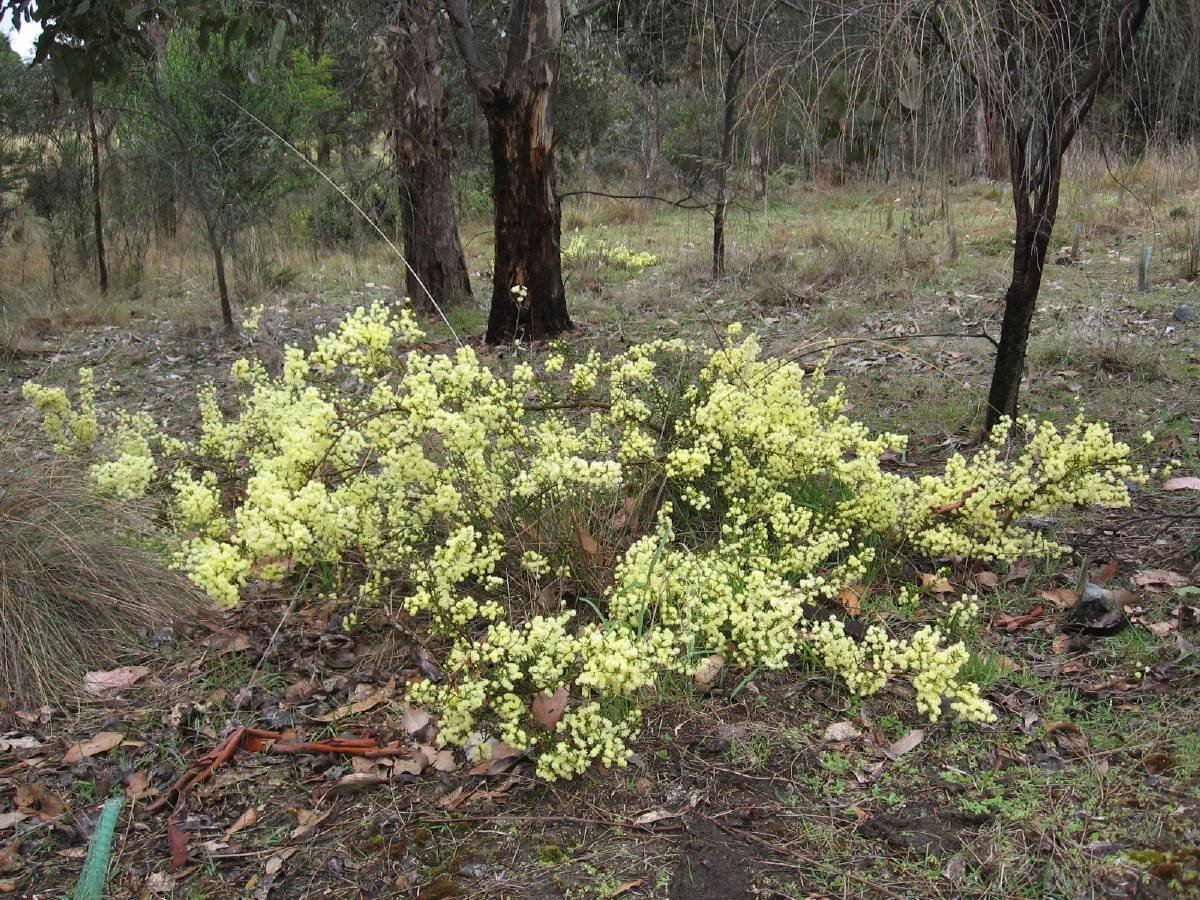 Acacia genistifolia, common name "Spreading Wattle", is found throughout the Knocklofty Reserve in all soils as an understory plant in open sunny places. It grows as an open upright or a compact prostrate, prickly shrub to 0.3m high by 1 to 3m wide. It has yellow, ball flowers in spring. It is a very hardy plant in most soils including dry sandy & wet clay soils and is frost tolerant. It responds well to pruning.
Acacia genistifolia, common name "Spreading Wattle", is found throughout the Knocklofty Reserve in all soils as an understory plant in open sunny places. It grows as an open upright or a compact prostrate, prickly shrub to 0.3m high by 1 to 3m wide. It has yellow, ball flowers in spring. It is a very hardy plant in most soils including dry sandy & wet clay soils and is frost tolerant. It responds well to pruning. Acacia gunnii, common name "Plowshare Wattle", occurs occasional in the sandy heath areas of Knocklofty Reserve, south east from the Forest Road carpark, along the Corby Avenue Track and downhill from the Reflecting Pond. It grows as a small, rigid, woody shrub, 0.3 to 0.5m high by 1 to 2m wide, with yellow ball flowers in spring. It prefers sandy or light clay soils in part sun and is dry and frost hardy. Often short lived in suburban gardens, it requires pruning to remain bushy but makes a good rockery plant.
Acacia gunnii, common name "Plowshare Wattle", occurs occasional in the sandy heath areas of Knocklofty Reserve, south east from the Forest Road carpark, along the Corby Avenue Track and downhill from the Reflecting Pond. It grows as a small, rigid, woody shrub, 0.3 to 0.5m high by 1 to 2m wide, with yellow ball flowers in spring. It prefers sandy or light clay soils in part sun and is dry and frost hardy. Often short lived in suburban gardens, it requires pruning to remain bushy but makes a good rockery plant.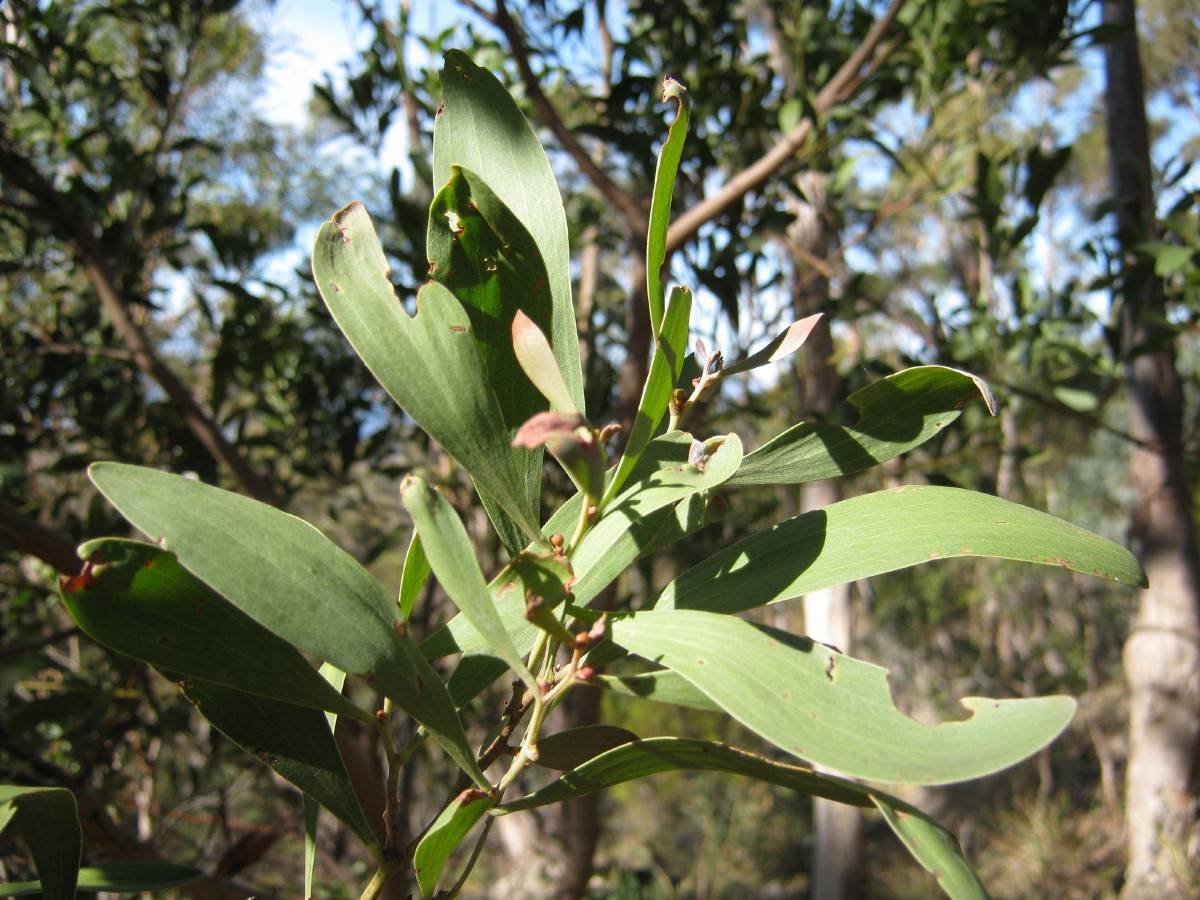 Acacia melanoxylon, common name "Blackwood", appears to have two forms, a large bush to small tree in dry locations and a very large, beautiful timber tree in high rainfall areas. That said this species can grow from 2 to 6m high by 2 to 3m wide or, 15 to 30m high by 10 to 15m wide. It has large, long, grey/green foliage and pale yellow, ball flowers singly or in racemes in spring. It grows in many places in Knocklofty Reserve in all soils, but as with this species throughout the country, best in wetter areas in part to full shade. It is an excellent shelter belt species and one of the longest living Acacia species. It is ideal for erosion control and may sucker if its roots are damaged.
Acacia melanoxylon, common name "Blackwood", appears to have two forms, a large bush to small tree in dry locations and a very large, beautiful timber tree in high rainfall areas. That said this species can grow from 2 to 6m high by 2 to 3m wide or, 15 to 30m high by 10 to 15m wide. It has large, long, grey/green foliage and pale yellow, ball flowers singly or in racemes in spring. It grows in many places in Knocklofty Reserve in all soils, but as with this species throughout the country, best in wetter areas in part to full shade. It is an excellent shelter belt species and one of the longest living Acacia species. It is ideal for erosion control and may sucker if its roots are damaged.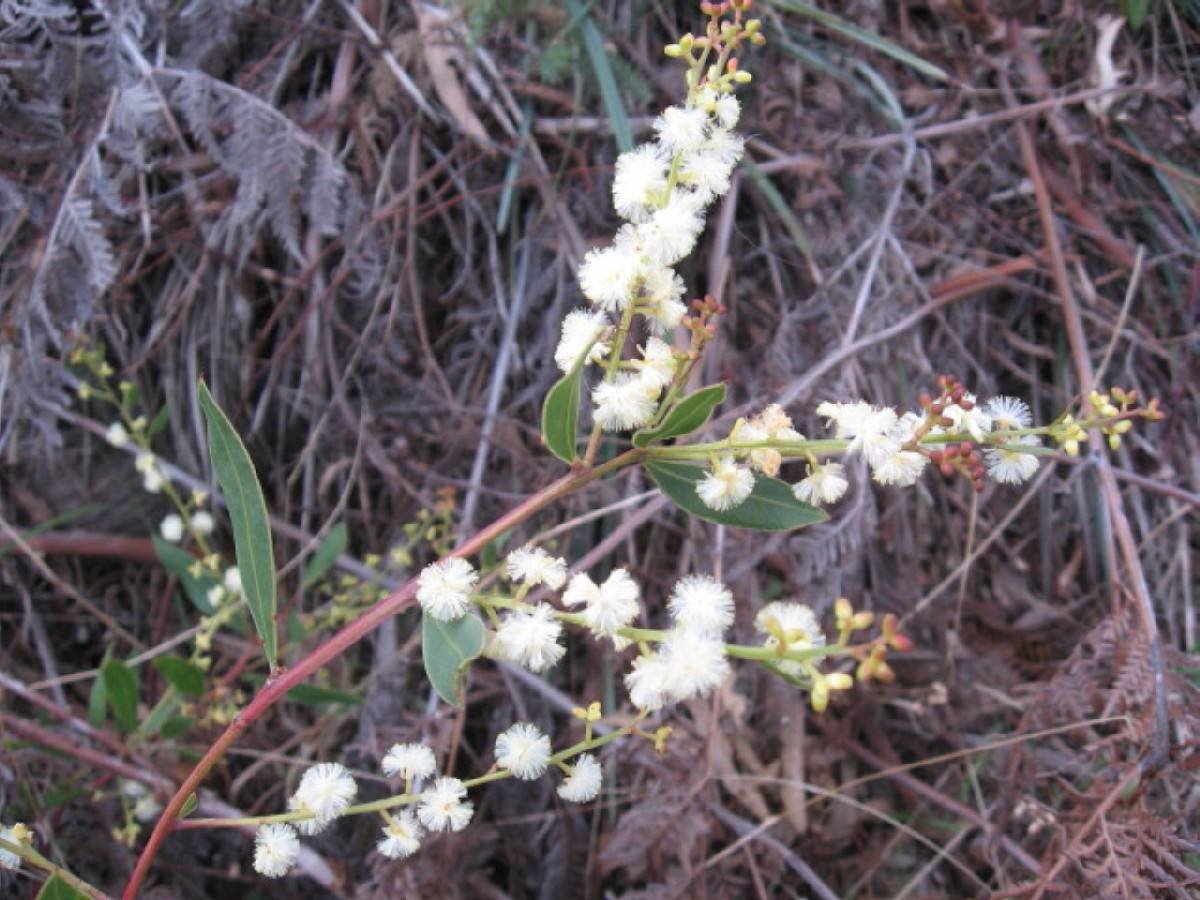 Acacia myrtifolia, common name "Red stem Wattle", is fairly rare on Knocklofty Reserve and because of its rarity has been planted in revegetation areas, unfortunately with limited success. This small open or dense shrub grows 1 to 2m high by 0.5 to 1.5m wide and has large white to cream, ball flowers in autumn to winter. It prefers light well-drained soils and grows best in full sun. It is an excellent revegetation plant especially if the planting area is well mulched. Again pruning can bring rewards with more flowers and a more compact bush. It has been planted in the mulch bed on the northern side of the Glover Track near the Poets Road carpark and beside the Main Trail on the western side near the Picnic Table Lookout.
Acacia myrtifolia, common name "Red stem Wattle", is fairly rare on Knocklofty Reserve and because of its rarity has been planted in revegetation areas, unfortunately with limited success. This small open or dense shrub grows 1 to 2m high by 0.5 to 1.5m wide and has large white to cream, ball flowers in autumn to winter. It prefers light well-drained soils and grows best in full sun. It is an excellent revegetation plant especially if the planting area is well mulched. Again pruning can bring rewards with more flowers and a more compact bush. It has been planted in the mulch bed on the northern side of the Glover Track near the Poets Road carpark and beside the Main Trail on the western side near the Picnic Table Lookout. Acacia riceana, common name "Arching wattle", was planted south of Janets Pond on Knocklofty Reserve before plantings were restricted to indigenous species. Several were planted in this area. This species is a tall shrub to small tree growing 3 to 6m high by 2 to 4m wide with arching branches and prickly dark green foliage in clusters. The lemon yellow, loose flower spikes are longer than the phyllodes (= 'leaves' or flattened stems in many wattle species) and appear in late winter through spring. In the home garden it requires moist soils in part shade and is an excellent hedging plant for restricting access and it responds well to hard pruning.
Acacia riceana, common name "Arching wattle", was planted south of Janets Pond on Knocklofty Reserve before plantings were restricted to indigenous species. Several were planted in this area. This species is a tall shrub to small tree growing 3 to 6m high by 2 to 4m wide with arching branches and prickly dark green foliage in clusters. The lemon yellow, loose flower spikes are longer than the phyllodes (= 'leaves' or flattened stems in many wattle species) and appear in late winter through spring. In the home garden it requires moist soils in part shade and is an excellent hedging plant for restricting access and it responds well to hard pruning.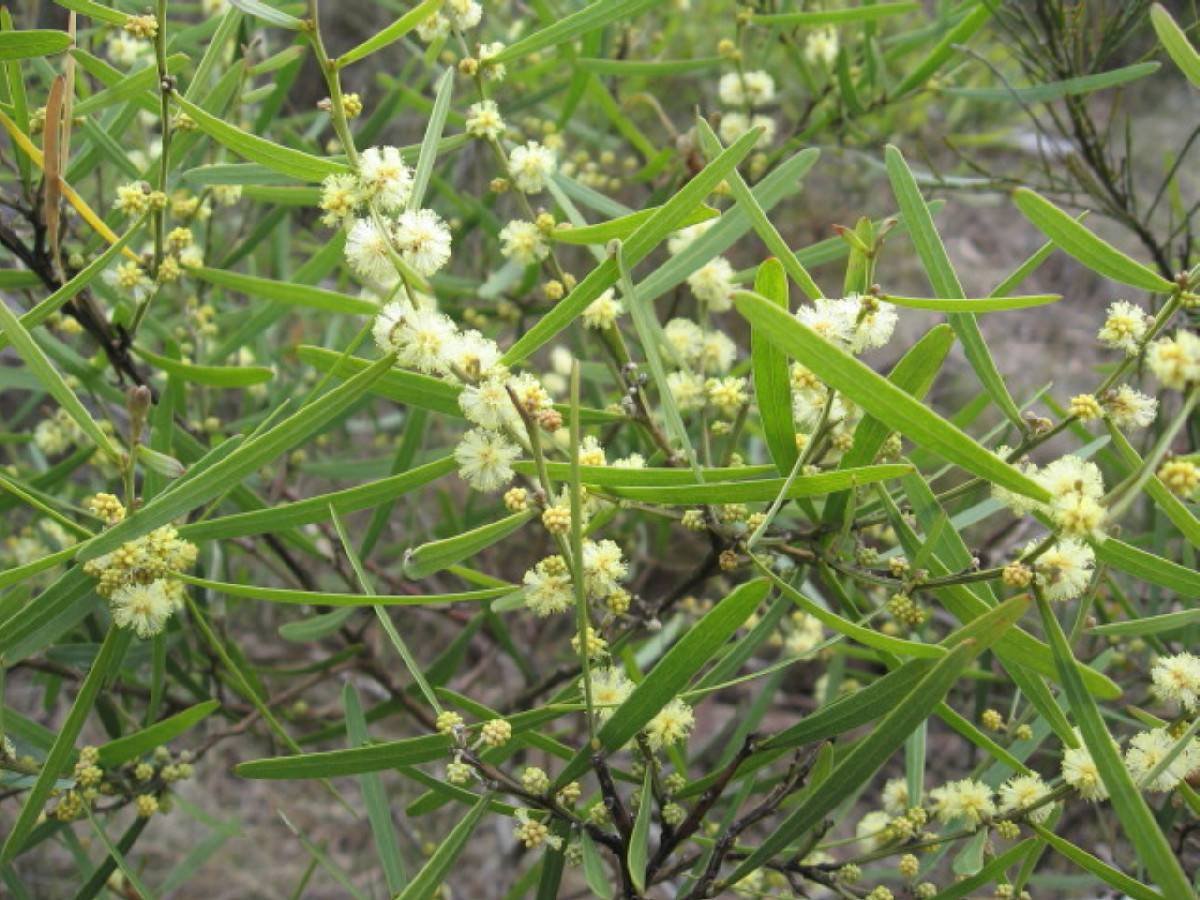 Acacia stricta, common name "Hop Wattle", grows in groves on the summit of Knocklofty Reserve and spasmodically on the slopes usually in dolerite soil. It is a hardy, erect shrub, 1 to 3m high by 1 to 2m wide with pale yellow flowers in late winter to early spring and prefers well drained soils in part to full sun. It is a good, coastal shrub and can be mass planted for hedging.
Acacia stricta, common name "Hop Wattle", grows in groves on the summit of Knocklofty Reserve and spasmodically on the slopes usually in dolerite soil. It is a hardy, erect shrub, 1 to 3m high by 1 to 2m wide with pale yellow flowers in late winter to early spring and prefers well drained soils in part to full sun. It is a good, coastal shrub and can be mass planted for hedging. Acacia verticillata, common name "Prickly moses", grows throughout the Knocklofty Reserve and as the common name suggests is a prickly, medium shrub to 2 to 6 m high by 3 to 5 m wide. Plants often have a profusion of lemon to yellow, rod flowers in spring. This species prefers moist, well drained soils and grows best in part to full sun. Plants should be pruned for compact shape and they make useful pedestrian traffic control plants.
Acacia verticillata, common name "Prickly moses", grows throughout the Knocklofty Reserve and as the common name suggests is a prickly, medium shrub to 2 to 6 m high by 3 to 5 m wide. Plants often have a profusion of lemon to yellow, rod flowers in spring. This species prefers moist, well drained soils and grows best in part to full sun. Plants should be pruned for compact shape and they make useful pedestrian traffic control plants. Allocasuarina littoralis, common name "Black sheoak", is a small tree growing 3 to 15m high by 2 to 6m wide, scattered throughout the drier areas of Knocklofty Reserve. The long, thin, green/brown branchlets with their circles of tiny, green teeth like leaves are adorned by brown whirls of flowers on the male plants, and red terminal tufts on female plants. This tree grows in most soils and is drought, frost & salt spray resistant.
Allocasuarina littoralis, common name "Black sheoak", is a small tree growing 3 to 15m high by 2 to 6m wide, scattered throughout the drier areas of Knocklofty Reserve. The long, thin, green/brown branchlets with their circles of tiny, green teeth like leaves are adorned by brown whirls of flowers on the male plants, and red terminal tufts on female plants. This tree grows in most soils and is drought, frost & salt spray resistant. Allocasuarina verticillata, common name "Drooping sheoak", grows throughout the Knocklofty Reserve as a small tree 6 to 10m high by 3 to 6m wide with long pendant branchlets with 9 to 12 sharp leaf teeth. In autumn through to spring this species can have yellow male flower spikes to 120mm long and red female flower tufts on short stems. Although it is drought and salt spray resistant, it can withstand period of wet soil; and may be frost tender when young.
Allocasuarina verticillata, common name "Drooping sheoak", grows throughout the Knocklofty Reserve as a small tree 6 to 10m high by 3 to 6m wide with long pendant branchlets with 9 to 12 sharp leaf teeth. In autumn through to spring this species can have yellow male flower spikes to 120mm long and red female flower tufts on short stems. Although it is drought and salt spray resistant, it can withstand period of wet soil; and may be frost tender when young.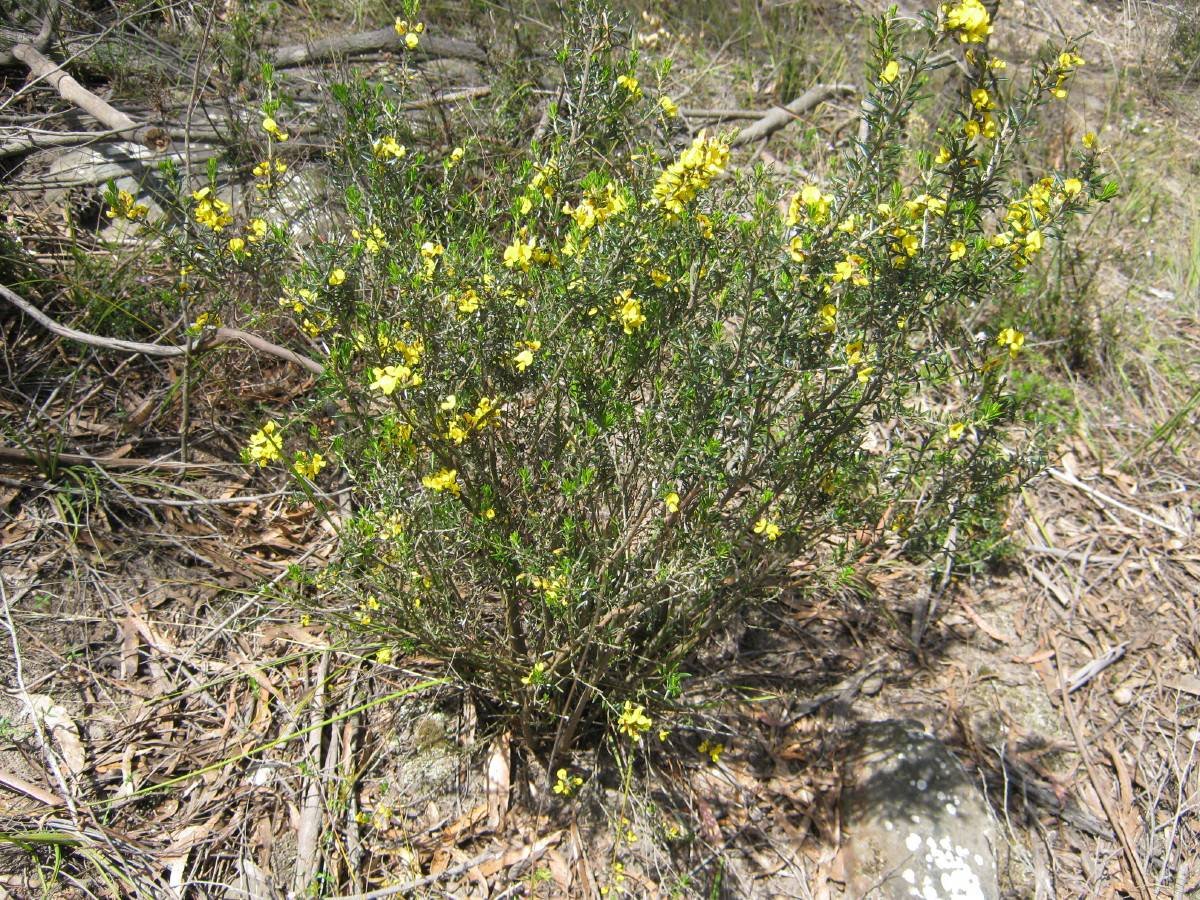 Aotus ericoides, common name "Golden pea", is a small, hairy shrub growing 0.5 to 1m high by 0.6 to 1m wide. The profuse, yellow, pea flowers, with red circles in their throats and splashes of red on the back of their keels, appear among the upper leaves in spring. The useful small plant prefers well drained soils in dappled shade but can withstand periods of wet soil and frost. The species is suitable for coastal plantings.
Aotus ericoides, common name "Golden pea", is a small, hairy shrub growing 0.5 to 1m high by 0.6 to 1m wide. The profuse, yellow, pea flowers, with red circles in their throats and splashes of red on the back of their keels, appear among the upper leaves in spring. The useful small plant prefers well drained soils in dappled shade but can withstand periods of wet soil and frost. The species is suitable for coastal plantings. Astroloma humifusum, common name "Native cranberry", grows as an understory plant throughout the Knocklofty Reserve especially under Eucalyptus species. A prostrate shrub it grows 0.1 to 0.3m high by 0.3 to 0.8m wide with small prickly leaves, and has red, tubular, autumn flowers followed by globular, edible fruit. It prefers well drained soils in part to full sun but can be hard to establish in domestic gardens.
Astroloma humifusum, common name "Native cranberry", grows as an understory plant throughout the Knocklofty Reserve especially under Eucalyptus species. A prostrate shrub it grows 0.1 to 0.3m high by 0.3 to 0.8m wide with small prickly leaves, and has red, tubular, autumn flowers followed by globular, edible fruit. It prefers well drained soils in part to full sun but can be hard to establish in domestic gardens. Austrodanthonia induta, common name "Tall wallaby Grass", is a rare and endangered grass species that occurs on the northern slopes of Knocklofty Reserve summit especially along the Summit Loop Track uphill from the seat corner. It grows in small erect, green, tussocks to 0.6m high. It has purplish flowers and seed heads in spring and grows mainly in dry soils in part to full sun.
Austrodanthonia induta, common name "Tall wallaby Grass", is a rare and endangered grass species that occurs on the northern slopes of Knocklofty Reserve summit especially along the Summit Loop Track uphill from the seat corner. It grows in small erect, green, tussocks to 0.6m high. It has purplish flowers and seed heads in spring and grows mainly in dry soils in part to full sun.